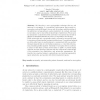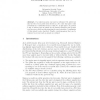CTRSA
2004
Springer
14 years 8 months ago
2004
Springer
We introduce a new cryptographic technique that we call universal re-encryption. A conventional cryptosystem that permits reencryption, such as ElGamal, does so only for a player w...
ADVIS
2004
Springer
14 years 8 months ago
2004
Springer
In this paper, a practical and secure e-mail system (called “PractiSES”) that performs public key distribution and management in a unique way is proposed. PractiSES is a networ...
EUROPKI
2005
Springer
14 years 8 months ago
2005
Springer
If a malicious party can insert a self-issued CA public key into the list of root public keys stored in a PC, then this party could potentially do considerable harm to that PC. In ...
CRYPTO
2005
Springer
14 years 8 months ago
2005
Springer
We describe two new public key broadcast encryption systems for stateless receivers. Both systems are fully secure against any number of colluders. In our first construction both...
HICSS
2005
IEEE
14 years 8 months ago
2005
IEEE
The goal of a Public-Key-Infrastructure (PKI) is to prove whether a cryptographic public key is authentic for a certain user. This information is crucial for the reliability of as...
IWCMC
2006
ACM
14 years 9 months ago
2006
ACM
The DNS Security Extensions (DNSSEC) were developed to add origin authentication and integrity. DNSSEC defined a public key infrastructure over DNS tree hierarchy for the public ...
ESAS
2007
Springer
14 years 9 months ago
2007
Springer
The problem of secure routing in mobile ad hoc networks is long-standing and has been extensively studied by researchers. Recently, techniques of aggregating signatures have been a...
ISCC
2008
IEEE
14 years 9 months ago
2008
IEEE
The GSM network with the greatest worldwide number of users, succumbs to several security vulnerabilities. The Short Message Service (SMS) is one of its superior and well-tried se...
CSE
2009
IEEE
14 years 10 months ago
2009
IEEE
—The success of a Public Key Infrastructure such as the Web of Trust (WoT) heavily depends on its ability to ensure that public keys are used by their legitimate owners, thereby ...


